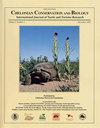Status of Olive Ridley Sea Turtles (Lepidochelys olivacea) After 29 Years of Nesting Rookery Conservation in Nayarit and Bahía de Banderas, Mexico
IF 0.8
4区 生物学
Q3 ZOOLOGY
引用次数: 7
Abstract
Abstract Olive ridleys (Lepidochelys olivacea) are the most numerous sea turtle species worldwide and also locally along the Pacific coast of Mexico. Published data on their distribution and nesting abundance along the coast of Nayarit and northern Jalisco, Mexico are, however, scarce. Here we describe the current extent of conservation activities and the history of efforts to protect sea turtles along this 394-km stretch of coastline. We found that 110 km (of the total of 394 km) are monitored by 18 sea turtle conservation programs, which in 2015 accounted for 43.2% of the total shoreline. Olive ridley sea turtle nesting was encountered on all monitored beaches. Our use of hatchery-protected nests as a measure of nesting levels is undoubtedly an underestimate of overall nesting in the region; however, it nevertheless provides a baseline of current nesting intensity in sites under conservation. Bahía de Banderas presented the highest nesting levels in the study area with 46.4% (3742 ± 904; mean ± SD) of the total protected nests (8073 ± 547) while only representing 14.2% (15.4 ± 3.8 km) of the total area monitored (109.6 ± 4.5 km). The results provided here represent a valuable baseline upon which future research and assessments can be built when analyzing the sea turtle conservation progress in the region.墨西哥Nayarit和Bahía de Banderas经过29年的巢室保护后,橄榄脊海龟(Lepidochelys olivacea)的状况
摘要Olive ridleys(Lepidochelys olivacea)是世界上数量最多的海龟物种,也是墨西哥太平洋沿岸的当地海龟。然而,关于它们在墨西哥纳亚里特海岸和哈利斯科北部的分布和筑巢数量的已公布数据却很少。在这里,我们描述了目前保护活动的范围,以及在这394公里长的海岸线上保护海龟的历史。我们发现,18个海龟保护项目监测了110公里(总长度394公里),2015年占总海岸线的43.2%。在所有被监测的海滩上都发现了奥利弗·里德海龟筑巢的情况。毫无疑问,我们使用孵化场保护的巢穴来衡量筑巢水平,低估了该地区的整体筑巢情况;然而,它仍然为保护区内当前的筑巢强度提供了一个基线。Bahía de Banderas在研究区域的筑巢率最高,为46.4%(3742 ± 904;意思是 ± SD) ± 547),而仅占14.2%(15.4% ± 3.8公里) ± 4.5公里)。这里提供的结果代表了一个有价值的基线,在分析该地区海龟保护进展时,可以在此基础上进行未来的研究和评估。
本文章由计算机程序翻译,如有差异,请以英文原文为准。
求助全文
约1分钟内获得全文
求助全文
来源期刊
CiteScore
1.70
自引率
14.30%
发文量
17
审稿时长
>12 weeks
期刊介绍:
Chelonian Conservation and Biology is a biannual peer-reviewed journal of cosmopolitan and broad-based coverage of all aspects of conservation and biology of all chelonians, including freshwater turtles, marine turtles, and tortoises. Manuscripts may cover any aspects of turtle and tortoise research, with a preference for conservation or biology. Manuscripts dealing with conservation biology, systematic relationships, chelonian diversity, geographic distribution, natural history, ecology, reproduction, morphology and natural variation, population status, husbandry, community conservation initiatives, and human exploitation or conservation management issues are of special interest.

 求助内容:
求助内容: 应助结果提醒方式:
应助结果提醒方式:


